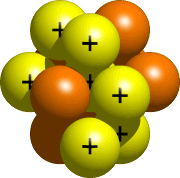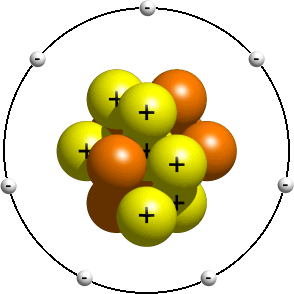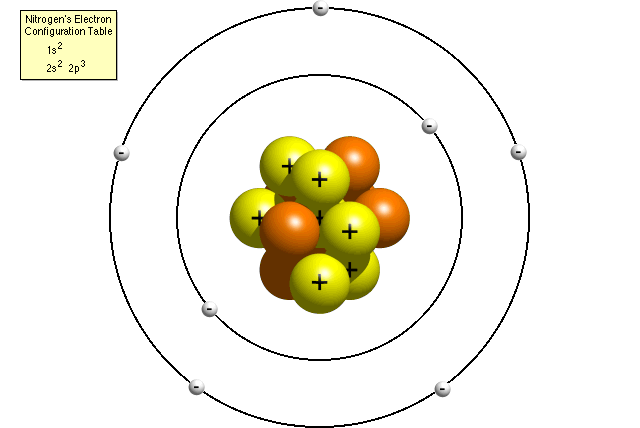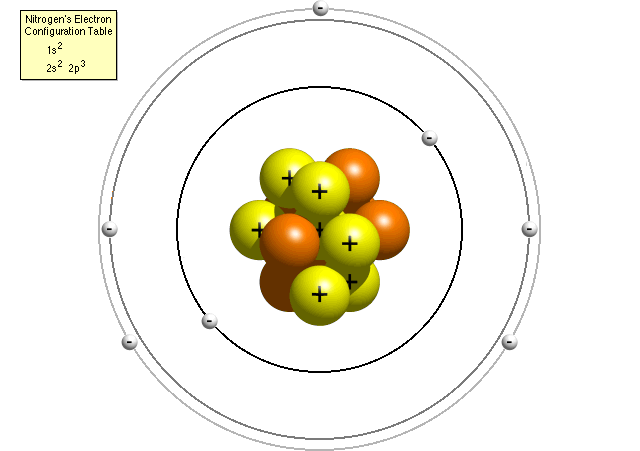Questions and Answers
How do I make a model of an atom?
Do you need to make a model or a drawing of an atom for science class? If so, follow these instructions to learn where all of the atom's pieces go.
Step 1 - Gather Information
Before you can build your model, you will need to know how many protons, neutrons and electrons your atom has. If you do not already know how to use the Periodic Table of Elements to find this information, read the 'How many protons, electrons and neutrons are in an atom of...?' page to learn how.
Let's use nitrogen as an example. Using information found on the Periodic Table of Elements, we can tell that an average atom of nitrogen contains 7 protons, 7 neutrons and 7 electrons.
Step 2 - Gather Materials
Now that you know how many protons, neutrons and electrons you will need for your model, it is time to decide what to use to represent them. Ping-pong balls, rubber balls, ball bearings, golf balls and styrofoam balls have all been used in the past. Basically, anything that is roundish and that can be glued to each other should work. It is helpful if the balls are color coded so that it is easier to tell which balls are protons, which are neutrons and which are electrons. It is also helpful if the electrons are smaller than the protons and neutrons.
Step 3 - Build the Nucleus
The nucleus, the central part of the atom, is made from protons and neutrons. All of your atom's protons and neutrons go in the nucleus. For nitrogen, the nucleus would look something like this:

Step 4 - Place the Electrons
The electrons are found outside the nucleus. How you place them depends on which model of atomic structure your class is studying. There are a few ways this can be done:
The Planetary Model
This model depicts an earlier view of the structure of the atom, shortly after the nucleus was discovered. This model is typically taught to younger students as an introduction to atomic structure. In it, the electrons are said to orbit the nucleus much like the planets in the solar system orbit the sun. Depending on your teacher, the actual orbits usually don't matter. Having the right number of electrons is usually good enough. A planetary model of a nitrogen atom could look something like this:

In the planetary model, a nitrogen atom has a central nucleus, composed of seven protons and seven neutrons, surrounded by seven electrons.
The Bohr Model
Scientists soon realized that the planetary model was an inaccurate description of atomic structure. They learned that electrons could only occupy certain orbits (usually referred to as energy levels or shells) around the nucleus. They also discovered that only a certain number of electrons could fit in each energy level.
To properly place the electrons around the nucleus, you will need to refer to your element's electron configuration table. To find your element's electron configuration table, go to the Periodic Table of Elements, click on your element and scroll to the bottom of the page. If you do not know how to read the electron configuration table, read the 'How do I read an electron configuration table?' page for help.
According to nitrogen's electron configuration table, an atom of nitrogen contains two electrons in its first energy level and five electrons in its second energy level. A Bohr model of a nitrogen atom could look like this:

In the Bohr model, a nitrogen atom has a central nucleus, composed of seven protons and seven neutrons, surrounded by seven electrons. Two of the electrons are in the first energy level while the other five are in the second energy level.
The Refined Bohr Model
Further studies showed that the Bohr model wasn't as accurate as it could be. Scientists learned that each energy level is made from a certain number of sub-shells. The sub-shells, which are named s, p, d and f, can each hold only a certain number of electrons. The s sub-shell can only hold 2 electrons, the p sub-shell can hold 6, the d sub-shell can hold 10 and the f sub-shell can hold 14. The number of available sub-shells increases as the energy level increases.
To properly place the electrons around the nucleus, you will need to refer to your element's electron configuration table. To find your element's electron configuration table, go to the Periodic Table of Elements, click on your element and scroll to the bottom of the page. If you do not know how to read the electron configuration table, read the 'How do I read an electron configuration table?' page for help.
According to nitrogen's electron configuration table, an atom of nitrogen contains two electrons in its first energy level (both in the s sub-shell) and five electrons in its second energy level (two in the s sub-shell and three in the p sub-shell). A more accurate Bohr model of a nitrogen atom could look like this:

In the refined Bohr model, a nitrogen atom has a central nucleus, composed of seven protons and seven neutrons, surrounded by seven electrons. Two of the electrons are in the s sub-shell of the first energy level, two are in the s sub-shell of the second energy level and three are in the p sub-shell of the second energy level.
Step 5 - Things to Remember
It is important to remember that a model is a simplified representation of an object. Some of the models discussed above are more accurate than others, but none of them are completely correct. Here are a couple of the things we have ignored:
The Size of the Nucleus
In the drawings above, the nucleus is too large. Or, put another way, if the nucleus is going to be that large, the electrons are too close. Real atoms are mostly empty space. If we wanted our drawings to be accurate, we would have to place the electrons about a mile away. Clearly, it would be difficult to bring a drawing that large to class.
Electrons do not Orbit the Nucleus
In the drawings above, we have drawn nice circles showing where the electrons go around the atom. In reality, scientists cannot tell exactly where an electron is at a given moment or where it is going. They can calculate the probability that an electron will be found in a given volume of space, but that isn't the same as knowing where that electron is. This behavior is described in the Quantum Model of the atom. Although it is the most accurate description that scientists currently have of the atom, it is much more difficult to understand.
Citation and linking information
For questions about this page, please contact Carol McKisson.
